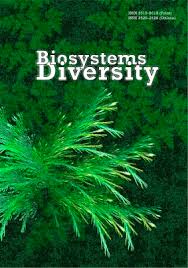Syntaxonomy and ecological differentiation of the pioneer vegetation of Ukraine. 2. Helichryso-Crucianelletea maritimae, Festucetea vaginatae, Koelerio-Corynephoretea canescentis classes
Syntaxonomy and ecological differentiation of the pioneer vegetation of Ukraine. 2. Helichryso-Crucianelletea maritimae, Festucetea vaginatae, Koelerio-Corynephoretea canescentis classes
Author(s): D.V. Dubyna, T.P. Dziuba, S. M. Iemelianova, P. A. TymoshenkoSubject(s): Geography, Regional studies, Agriculture, Energy and Environmental Studies, Sociobiology
Published by: Дніпропетровський національний університет імені Олеся Гончара
Keywords: psammophytic vegetation; classification; new-formed ecotope; ecological gradients; cluster analysis; DCA-ordination;
Summary/Abstract: Pioneer psammophytic vegetation is usually developed on wind-drift sandy substrates such as arenas, spits, beaches, river terraces, and this vegetation occupies significant areas in all three natural zones of Ukraine. The Koelerio-Corynephoretea canescentis class was represented by 13 associations, 3 alliances and 1 order; Festucetea vaginatae class by 22 associations, 2 alliances and 1 order; Helichryso-Crucianelletea maritimae by 10 associations, 4 alliances and 1 order. The results of cluster analysis and synoptic tables of the classes are presented. 9 alliances are briefly described. Leading factors of territorial and ecological differentiation are identified. It was found that the territorial distribution of plant communities is influenced by the character of ecotope mesorelief, soil composition and humus horizon thickness, as well as the degree of eolian processes development. The main factors of their ecological differentiation are soil acidity, salt regime and ombroregime. Based on the results of DCA-ordination of syntaxa within certain vegetation classes, it was found that their distribution is influenced by factors that correlate with the environment-specific conditions. It has emerged that an ecological differentiation of syntaxa within Festucetea vaginatae is determined by the integrated effect of gradients, and soil salinity is leading among them. Temperature regime and climate continentality are leading factors in the distribution of syntaxa within the Koelerio-Corynephoretea canescentis class. The gradients of ombroregime and soil humidity have a significant impact. The distribution of communities of the Helichryso-Crucianelletea maritimae class in the ecological space is determined mainly by factors of variability of damping, ombroregime and climate continentality. The author’s syntaxonomic concept assumes the independence of the studied classes: Koelerio-Corynephoretea canescentis, Helichryso-Crucianelletea maritimae and Festucetea vaginatae, conside¬ring that the leading factors of community differentiation of the Festucetea vaginatae and Koelerio-Corynephoretea canescentis classes are the origin (genesis) of sandy substrates, as well as soil acidity. Phytosociological analysis of a large number of relevés of coastal littoral vegetation also provides support for independence of the Helichryso-Crucianelletea maritimae and Ammophiletea classes diffe¬rent floristically and ecologically. A review of the psammophytic vegetation of Ukraine will determine the place of the selected syntaxonomic units in the pan-European system.
Journal: Biosystems Diversity
- Issue Year: 28/2020
- Issue No: 3
- Page Range: 298-319
- Page Count: 22
- Language: English

